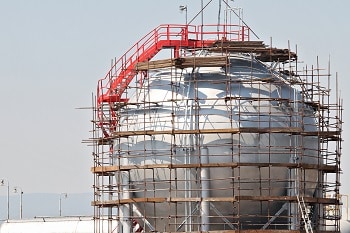An In-depth Overview of Storage Tank Welding Examination Criteria and Methodologies for Improved Weld High Quality and Efficiency
The relevance of welding assessment requirements in the manufacturing of tanks can not be overstated, as they offer as the backbone for guaranteeing weld integrity and operational integrity. Numerous assessment methods, including aesthetic analyses and progressed non-destructive screening methods, are vital in identifying potential imperfections that might jeopardize performance.
Value of Welding Evaluation Requirements

Welding assessment standards include a variety of standards, consisting of material specs, welding procedures, and qualifications of workers associated with the welding process. By applying these standards, organizations can methodically recognize and correct prospective defects, therefore minimizing the chance of costly repair services or catastrophic failures. Extensive examination practices cultivate a culture of accountability and precision, motivating welders to keep high levels of workmanship.

Common Welding Inspection Strategies


Ultrasonic Evaluating (UT) is one more prevalent method, utilizing high-frequency acoustic waves to spot inner imperfections that might not show up externally. This technique is especially effective for recognizing voids or additions within the weld metal. Magnetic Bit Examining (MT) is additionally extensively made use of, specifically for ferromagnetic materials, as it reveals surface and near-surface problems through the application of magnetic fields and ferrous fragments.
Furthermore, Liquid Penetrant Screening (PT) detects surface-breaking defects by applying a penetrant to the weld and after that making use of a designer to draw out the penetrant. Each of these techniques adds to a comprehensive inspection approach, guaranteeing that welds satisfy the rigorous quality requirements required in container building.
Governing Specifications and Compliance
Governing requirements and conformity are necessary components in making sure the security and dependability of welded structures in tank building and construction - Tank Welding Inspection. These requirements serve to develop minimum demands for material buildings, welding procedures, and examination techniques, thus lowering the risk of architectural failures and boosting overall performance
Key organizations, such as the American Culture of Mechanical Designers (ASME) and the American Welding Culture (AWS), provide guidelines that are commonly adopted in the industry. Conformity with these go right here standards not only guarantees adherence to best techniques but likewise satisfies legal and contractual obligations, guarding the interests of stakeholders.
Regulatory bodies frequently mandate adherence to details codes, such as ASME Code Section IX for welding certifications and API 650 for welded tanks. These codes lay out demands for welding techniques, certifications of personnel, and screening techniques to validate weld stability.
Normal audits and inspections are crucial to preserving conformity, as they aid determine variances from developed requirements. Non-compliance can result in substantial penalties, job hold-ups, and safety and security hazards. Thus, a robust understanding of regulative standards and a commitment to compliance are critical in achieving top notch and resilient welded tank frameworks.
Non-Destructive Checking Methods
Exactly how can click here now the integrity of bonded structures be assured without creating damages? Non-destructive testing (NDT) methods supply a robust remedy, allowing assessors to assess weld high quality without endangering the product - Tank Welding Inspection. Among the most common NDT methods are ultrasonic screening (UT), radiographic screening (RT), magnetic fragment testing (MT), and color penetrant screening (PT)
Ultrasonic screening uses high-frequency acoustic waves to discover inner imperfections and characterize product residential properties. It offers accurate measurements and is particularly reliable for thick products. Radiographic screening involves passing X-rays or gamma rays with the weld, developing photos that reveal architectural problems such as fractures or voids. This technique is vital for analyzing the integrity of intricate welds.
Magnetic particle screening is suited for ferromagnetic products, where electromagnetic fields reveal surface area and near-surface interruptions. Dye penetrant testing makes use of a liquid dye to highlight surface-breaking imperfections, making it a reliable technique for non-porous materials.
Each of these NDT approaches has unique benefits, permitting detailed analyses customized to particular materials and welding procedures. By carrying image source out these methods, sectors can ensure the integrity and safety and security of welded structures, eventually enhancing total performance.
Enhancing Weld Quality Through Examination
Efficient inspection plays a crucial duty in boosting weld quality, working as a vital checkpoint in the manufacture procedure. By determining potential defects early, inspections minimize the danger of endangered structural honesty and make sure conformity with market standards. Utilizing a combination of visual assessments, non-destructive screening (NDT) techniques, and mechanical analyses, examiners can find problems such as porosity, splits, and insufficient combination.
Applying a durable inspection protocol not only enhances the overall top quality of welds but additionally fosters a culture of accountability among welders and producers. Routine training and accreditation of inspection employees make certain that they are outfitted with the required skills to acknowledge and attend to possible problems properly. This positive approach lessens rework and linked prices, inevitably contributing to predict effectiveness.
Additionally, extensive paperwork of assessment searchings for provides valuable understandings right into recurring issues, helping with continuous renovation in welding techniques. By leveraging sophisticated innovations, such as automated ultrasonic testing or digital radiography, weld high quality can be improved via a lot more exact evaluations. Finally, an extensive examination procedure is vital in accomplishing premium welds, making sure safety, reliability, and durability in tank manufacture.
Conclusion
In conclusion, the application of rigorous container welding examination requirements and techniques is essential for ensuring weld honesty and performance. By making use of a mix of aesthetic evaluations, non-destructive testing techniques, and adherence to governing criteria, organizations can successfully recognize and minimize possible flaws.